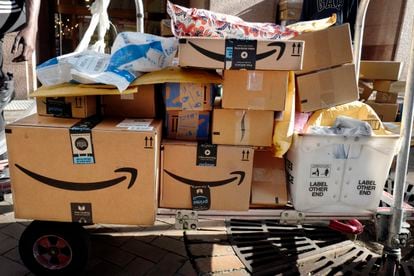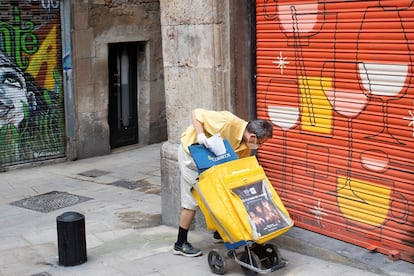Gastos de envío GRATIS
Envío GRATIS
Desde 49,99€


When Ana Magallón sold her first order to Hawaii, she got a little excited. "I thought: look how exotic, one of our pieces is going to travel from Avilés to an island paradise," he recalls. Then he started doing the math and got a little less excited. The piece in question, a ceramic mermaid, cost 10 euros. The shipment cost 15. "We assumed some of the cost so that it did not seem so expensive," explains the artisan of the store on-line Guessing . It is a common practice in the world of e-commerce . The seller assumes part or all of the shipping costs so as not to scare the customer away. This reduces the profit margin but increases sales. This, if you are a large company, can work; if you are a small artisan, like Magallón, it can end up suffocating you. Free shipping does not exist and it is everywhere. Amazon guarantees it for 36 euros per year. Aliexpress offers it widely. Etsy recommends it to its sellers as a marketing strategy. marketing . All the ecommerce they have imitated a tactic that is based on two principles: do it fast and do it free. When you press the buy button, a time trial is launched, a relay race that reaches the finish line when the messenger knocks on your door. At some point in that chain, the shipping costs that you have not paid are charged. Someone pays the price: the delivery people who live in precarious conditions, the Post Office, which provides a loss-making service subsidized by the State, or the seller, which reduces its profit margin to compete in the fierce world online .
It hasn't always been like this. When Magallón founded her shop with the classmates from a ceramics course, things were different. “I had some previous experience on the Internet, so I jumped in and we started at Etsy,” explains the entrepreneur. "We had already sold something within a week." It was 2014 and the customer mentality was very different from today. "I assumed the shipping costs without a problem," explains Magallón. "I understood that there was a job behind it and that it had to be paid for." But when large companies saw that there was business potential on the Internet, they began to attract customers with aggressive offers such as free shipping. Small stores had to imitate them to continue selling. And they began to assume costs in a general way. Barruntando, for example, has ended up absorbing the shipping costs within Spain and sharing them with the client when they are abroad. E-commerce in Spain moves about 12,000 million euros per quarter . It has become the goose that lays the golden eggs, but the conditions in which they are hatched are increasingly precarious. "For years free shipping has been promoted because it was the way to compete in a growing market and because, in many cases, the numbers allowed it," explains the technology consultant. Jose Carlos Cortizo . It is a process that is still active and at cruising speed: the growth of this market is close to 30% year-on-year in Spain. There is room to continue retaining new audiences and the easiest way to do it is by eliminating expenses. The brands continue to adjust prices and there are those who get out of this crazy competition along the way. "Within this maelstrom, many merchants are forced to sell at prices that make the accounts do not come out," acknowledges Cortizo. Traditionally, this trend is blamed on large marketplaces like Amazon, but this is a half truth. "It is true that they are the generators of this competitive dynamic, because in the end they incorporate it into their platform [if you give a better price and eliminate added costs, you appear earlier in searches and sell more] but it is also what consumers ask for."
He pain of paying or pain to pay is a theory of behavioral economics which ensures that there are certain psychological barriers that can prevent us from making a certain purchase. The use of cash instead of credit cards is a good example. Convenience charges (such as the high price of a soft drink in the hotel minibar), too. But nothing exemplifies this consumer attitude better than shipping costs. That handful of euros that are added at the end of the process causes many to give up before pressing the "buy" button. That is why some have chosen to disassociate this expense from the moment of payment and camouflage it under another guise. "Amazon Prime is disguised with a package of series and movies," he explains Jordi Ordóñez , expert consultant in electronic commerce. “It is an effective way of attracting customers, so you eliminate the barrier of shipping costs at the time of purchase and offer a bonus. And it works: the Amazon Prime customer buys two or three times more than the one who doesn't have it”. Ordóñez believes that the price of this service will go up over the years and this will calm things down, but for now they are still in the recruitment, loyalty and growth phase. And they continue on sales: free shipping has been added to the return at no additional cost. It is not a marginal amount. Around the 25% of products or services purchased on the Internet are returned , a percentage that rises to 30% in the case of clothing. When it arrived in Spain, Amazon relied on companies like Seur or MRW. They gave him a welcome worthy of Mr. Marshall, but soon realized that the American did not deserve such joy. "At first everything went very well but then they began to push: if you should lower the price, if you always have to arrive on time... there came a point where it was unsustainable," recalls Ordóñez. That point occurred on Black Friday 2016, when the shipping companies collapsed. The volume was increasing, but the profit per package was decreasing. And the reputation of these companies, with cumulative delays of more than a week, fell to the ground. “Imagine that a single client saturates your entire distribution network. Others complain and rightly so. And think that those others pay better. In the end you see that it does not pay off ”, settles the expert. Little by little, the big delivery companies stopped working with Amazon. The technological giant solved this gap by setting up its own logistics network based on freelancers and subcontractors. Precarious shipment. For the least grateful packages, those destined for distant towns and remote houses, the accounts still did not come out. So he chose to find an ally in need.

Correos is obliged by law to provide the universal postal service and guarantee the delivery of letters and packages throughout the Spanish territory at a competent price. "This makes it have a brutal capillarity," says José Carlos Cortizo. And an equally brutal cost. "Since fewer letters are sent, which is what gave meaning to the service, it is increasingly deficient." Spain pays Correos about 142 million a year as compensation for the losses of the universal postal service. In this situation, a company like Amazon arrives and offers a payment, albeit precarious, for using a network that has to be maintained and paid for by law, whether or not it is used. The answer is clear. "You have no choice but to accept," concludes Cortizo. "Amazon is taking advantage of the need for the Post Office." Jordi Ordóñez justifies this behavior with an argument that is difficult to refute: “In the end they are companies, not NGOs, they have to make money. If they cannot charge these costs to the client, they have to charge it somewhere”. This additional cost is distributed throughout the chain, but it is usually the weakest link, that of logistics, who assumes the greatest part. It already happened with the deliveries and food at home. Now that scheme is being imitated in purchases online . "It is the least valued part," acknowledges Ordóñez. “Quite ironically, because if you think about it, it's the only point of contact between the store and the customer. It is the visible face”. Ana Magallón, now after the hardest months of the crisis, is once again more busy in the workshop. “We are resuming all the shipments that we had left paralyzed during these months of the pandemic,” she says with relief. Background noise is heard, there is already bustle in his workshop in Avilés. Women who model, paint, wrap and send ceramic figurines. Magallón answers surprised when asked why they don't turn that workshop into a store and leave the world online . "It's just that we wouldn't sell anything that way, and we would have a lot more expenses," he replies. The sale on-line It has its cons but the pros, for now, win by a landslide. “We have shipments to Puerto Rico, Qatar, the Philippines, South Africa…”, lists Magallón. There is no discussion possible. Barruntando will continue packing ceramic little mermaids to send them to all corners of the world. Pay whoever pays shipping costs.
Leave a comment